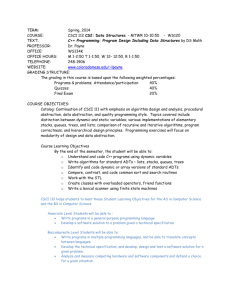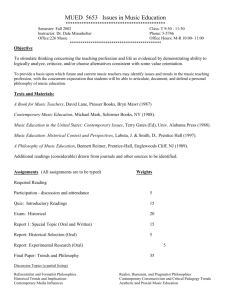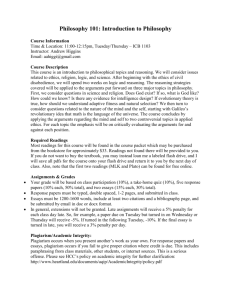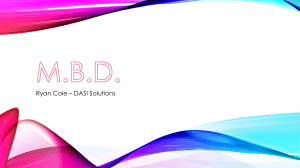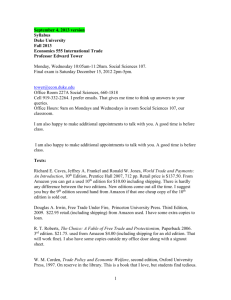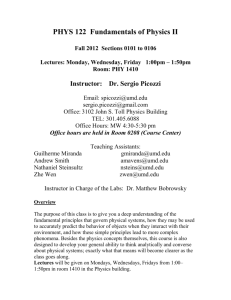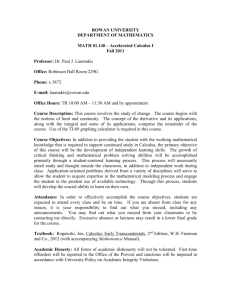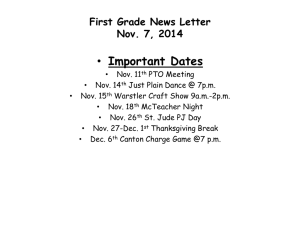01 - Western Engineering
advertisement
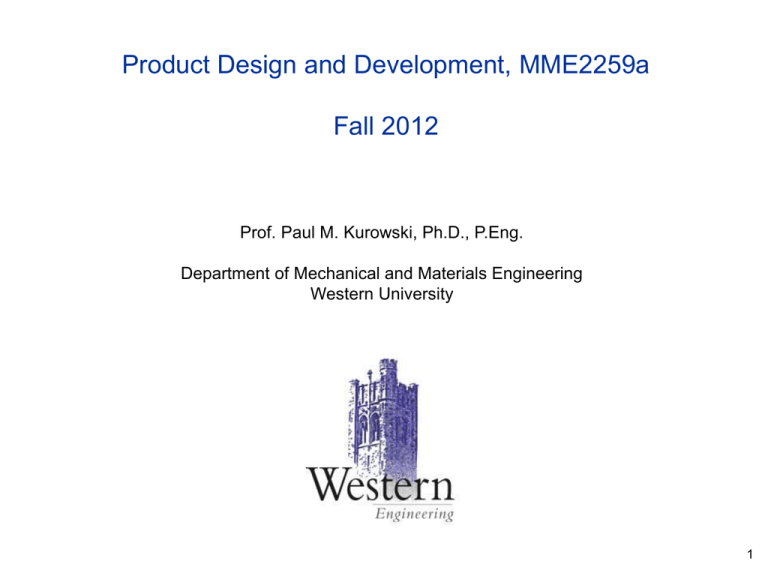
Product Design and Development, MME2259a Fall 2012 Prof. Paul M. Kurowski, Ph.D., P.Eng. Department of Mechanical and Materials Engineering Western University 1 WHAT IS A DESIGN? • Design is the quest for simplicity and order. • Explicit in the term design are the concepts of order and organization. • Design is the process of inventing artifacts that display a new physical order, organization, and form in response to function. • Design is a conscious and intuitive effort directed toward the ordering of the functional, material, and visual requirements of the problem. • Design is a statement of order and organization. Its goal is unity. It must hold together. It is an expression of the human ubiquitous quest for order. • Design implies intention, meaning, and purpose. • The planning and patterning of any act toward a desired, foreseeable end constitutes the design process. 2 DESIGN IS COOL The notion of bringing something into being that did not exist before, whether from scratch or on the foundation of an existing design, is fascinating. Could there be a headier pursuit than participating in creation itself? Machine Design August 7, 2008 3 OBJECTIVE MME2259a Considering that designing is creative activity, the objective of MME2259a is to introduce design methodology and design tools (applicable to Mechanical Engineering) which are used to execute this creative design process with the objective of creating products that satisfy customers’ needs. 4 OBJECTIVE MME2259a Please download from our web page and read (CDEN2006) 5 PROCESS OF DESIGN Products that Meet Need Design Need Paths of the Design Process Design Knowledge Manufacturing Material Science Kinematics Physics Electronics Economics Thermodynamics Mechanics 6 TYPES OF ENGINEERING DESIGN (i) Selection Design – choose item(s) from a catalog (ii) Configuration Design – organize the packaging of components (iii) Parametric Design – finding variables or parameters. (iv) Redesign, alternative design – modifying an existing product. (v) Original Design – develop a totally new product. 7 SELECTION DESIGN Given: Shaft diameter Speed Radial force 20 mm 2000 rpm 6675 N (or 1500 lb) Housing Bearing 20 mm 6675 N Shaft Require: To select an appropriate bearing. Possible Solutions: [Ullman 1992] 8 SELECTION DESIGN “Fundamentals of Engineering Design” Barry Hyman, Prentice Hall 9 CONFIGURATION DESIGN Computer components: Keyboard Mother board Extension slots Floppy drive Power supply Possible configurations for a computer (in each case, the bottom of the sketch represents the front of the computer). 10 CONFIGURATION DESIGN “Fundamentals of Engineering Design” Barry Hyman, Prentice Hall 11 CONFIGURATION DESIGN Configuration design Selection and arrangement of components on a product Selection and arrangement of features on a part Factors in configuration design Spatial limitations Product interactions with other physical objects and the user(s) Maintenance Wear Desired customization by the user Need to include standard parts and assemblies Need to conform to industrial standards Need to replace consumable materials 12 CONFIGURATION DESIGN Design for function check list Configuration alternatives can be analyzed according to Design for function Strong Stiff or flexible Buckle resistant Thermal expansion Design for assembly Vibration Design for manufacture Noise Heat transfer Fluids transport/storage Energy efficient Stable Reliable Human factors/ergonomics Safe Easy to use Maintainable Repairable Durable Life cycle cost Styling/aesthetics 13 PARAMETRIC DESIGN Example: Design a cylindrical storage tank that holds 4 m3 of liquid. l Volume: V = p x r2 x l thus 4=pxr2xl 1.273 = r 2 x l 2r Note: There are an infinite number of values for (r, l); therefore more information is necessary. 14 PARAMETRIC DESIGN “Fundamentals of Engineering Design” Barry Hyman, Prentice Hall 15 REDESIGN 1890 Humber bicycle 1990 Trimble bicycle 16 ORIGINAL DESIGN ? Boeing 787 www.elmundo.es 17 ANALYSIS VS. DESIGN Analysis Problem – a well defined problem with one correct solution. Design Problem – an ill-defined problem with numerous satisfactory solutions. Example: The problem of designing a simple lap joint. Analysis Problem – What size of SAE Grade 5 bolt should be used to fasten together two pieces of 1045 sheet steel, each 4 mm thick and 60 mm wide, which are lapped over each other and loaded with 100N ? Design Problem – Design a joint to fasten together two pieces of 1045 sheet steel, each 4 mm thick and 6 cm wide, which are lapped over each other and loaded with 100N. 18 ANALYSIS VS. DESIGN SAE Specifications for Steel Bolts http://www.americanfastener.com/technical/grade_markings_steel.asp 19 MME2259a WEBPAGES http://www.eng.uwo.ca/MME2259a/2012 http://www.eng.uwo.ca/designcentre http://www.eng.uwo.ca/mechanical/undergrad/curre nt/course_outlines.htm 20 LAB SCHEDULE Sep. 11, Sep.13 Laboratory: Lab. Homework: Problem Statement QFD; Design Specifications Sep. 18, Sep. 20 Laboratory: Lab. Homework: Product Design Specifications, Program Plan Planning and Scheduling the Project Sep. 25, Sep. 27 Laboratory: Lab. Homework: Design Review Meeting # 1 Concept Generation and Evaluation Oct. 2, Oct. 4 Laboratory: Lab. Homework: Concept Generation and Evaluation Concept Generation and Evaluation Oct. 9, Oct. 11 Laboratory: none (Thanksgiving Holiday) Lab. Homework: Preparation for Design Review # 2 Oct. 16, Oct. 18 Laboratory Lab. Homework Design Review Meeting # 2 Detailed Design Oct. 23, Oct. 25 Laboratory: Lab. Homework: Detail Design Detail Design Oct. 30, Nov. 1 Laboratory: Lab. Homework: Detail Design Detail Design Nov. 6 Nov. 8 Laboratory: Lab. Homework: Detail Design Detail Design Nov. 13, Nov. 15 Laboratory: Lab. Homework: Design Review Meeting # 3 Detail Design Nov. 20, Nov. 22 Laboratory: Lab. Homework: Detail Design, Design Simulation Detail Design, Design Simulation Nov. 27, Dec. 29 Laboratory: Lab. Homework: Detail Design, Design Simulation Detail Design, Design Simulation Dec. 4, Dec. 6 Laboratory: Lab. Homework Final presentations none Notes The final design report, Product Development File (PDF) binder and the individual design notebooks are due on the last day of classes. The above schedule and topics are subject to adjustments and changes as needed. 21 MARKING Individual marks Two individual assignments (5% each) 10% Oct 1st, 2012, Nov. 19th, 2012 Midterm examination 20% Nov. 6th, 2012 Final examination (limited open book) 50% Fall examination session Team marks Individual Design Notebook Final report and Product Data File Design presentations (1% each) 5% 12% 3% Successful completion of the Certified SolidWorks Associate (CSWA) exam will count as a bonus assignment worth 5%. 22 DESIGN PROCESS AND THE PRODUCT LIFE-CYCLE Product Design Manufacturing Process Design Requirements Definition Manufacturing System Concept Development Concept Development Detailed Process Design Detailed Product Design Prototype QFD Process FMEA Simulation QFD Process FMEA Taguchi DFM Validation Testing Poke Yoke Simulation The extend of our design project Manufacturing Service & Support 23 TYPES OF ENGINEERING DESIGN - AGAIN In our design project focus will be on selection design (i) Selection Design – choose item(s) from a catalog (ii) Configuration Design – organize the packaging of components (iii) Parametric Design – finding variables or parameters. (iv) Redesign, alternative design – modifying an existing product. (v) Original Design – develop a totally new product. 24 MME2259a vs ES1050 25 COURSE PROGRESS Lectures Labs SolidWorks 26 CSWA EXAM - BONUS https://www.virtualtester.com/solidworks/branding/user-portal/user-portal.html 27 CSWA http://www.sdcpublications.com/Textbooks/Official-Certified-SolidWorks-Associate-Examination/ISBN/978-1-58503-656-1/ 28 DESIGN PROJECT The goal of the term project is to design a consumer product such as: log splitter, wheelbarrow, utility trailer, boat trailer, towing hitch, bicycle hitch carrier, car turntable etc. The selected project must allow the design team to use CAD design techniques such as assemblies, weldments and sheet metal. It also must allow the use of Motion Simulation. The choice of product will be made by design team and will be approved by course instructor. Each design team will: identify the need establish relevant design specifications generate and evaluate several concepts develop detailed design including engineering drawings develop design documentation use design simulation (limited to Motion Simulation) to investigate product performance 29 truss.SLDPRT 30 sheet.SLDPRT 31 HOMEWORK • Form design teams - 4 people • Buy design notebook and bring it to the lab next week • Think about your design project, we’ll decide next week in the lab • Install SolidWorks 2012 32 SOLIDWORKS INSTALLATION To install SolidWorks go to: www.solidworks.com/SEK Use SEK-ID = XSEK12 Ask Maryam Refan (mrefan@uwo.ca) for serial number for activation 33 Sample projects 34 Boat cargo crane 35 A davit (dāv'ĭt, dā'vĭt) is a structure, usually made of steel, which is used to lower things over an edge of a long drop off such as lowering a maintenance trapeze down a building or launching a lifeboat over the side of a ship. Davit holding a rescue boat 36 Railway tricycle 37 Hand cart 38 Hand cart 39 Wheelbarrow 40 Boat trailer 41 Pedal kart – 4 wheeler 42 Pedal kart – 3 wheeler 43 Car turntable 44 Log splitter 45 Utility trailer 46 Engine hoist 47 Engine stand 48 Transmission jack 49 Mechanics creeper 50 Bicycle rack 51 Towing attachment 52 Where to look for project ideas? 53

